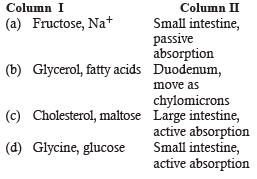31 Years NEET Previous Year Questions: Digestion & Absorption - 1 (Old NCERT) - NEET MCQ
30 Questions MCQ Test - 31 Years NEET Previous Year Questions: Digestion & Absorption - 1 (Old NCERT)
Succus entericus is referred to as: [NEET 2021]
Identify the correct statement with reference to the human digestive system. [NEET 2020]
| 1 Crore+ students have signed up on EduRev. Have you? Download the App |
Which of the following terms describes human dentition? [NEET 2018]
Which cells of ‘Crypts of Lieberkuhn’ secrete antibacterial lysozyme? [NEET 2017]
Which hormones do stimulate the production of pancreatic juice and bicarbonate? [NEET 2016]
Pancreatic juice is stimulated by the release of
Which group of three of the following five statements (a-e) contain is all three correct statements regarding beri-beri? [2005]
(a) a crippling disease prevalant among the native population of sub-Saharan Africa;
(b) a deficiency disease caused by lack of thiamine (vitamin B1)
(c) a nutritional disorder in infants and young children when the diet is persistently deficient in essential protein;
(d) occurs in those countries where the staple diet is polished rice;
(e) the symptoms are pain from neuritis, paralysis, muscle wasting, progressive oedema, mental deterioration and finally heart failure;
A patient is generally advised to specially, consume more meat, lentils, milk and eggs in diet only when he suffers from [2005]
Epithelial cells of the intestine involved in food absorption have on their surface:
Secretin and cholecystokinin are digestive hormones. They are secreted in : [2005]
Angiotensinogen is a protein produced and secreted by [2006]
A person who is one along hunger strike and is surviving only on water, will have [2007]
Which one of the following is a fat-soluble vitamin and its related deficiency disease? [2007]
What will happen if the secretion of parietal cells of gastric glands is blocked with an inhibitor? [2008]
Which one of the following is the correct matching of the site of action on the given substrate, the enzyme acting upon it and the end product? [2008]
Modern detergents contain enzyme preparations of: [2008]
When breast feeding is replaced by less nutritive food low in proteins and calories; the infants below the age of one year are likely to suffer from: [2009]
A young infant may be feeding entirely on mothers milk which is white in colour but the stools which the infant passes out is quite yellowish. What is this yellow colour due to ? [2009]
Which one of the following statements is true regarding digestion and absorption of food in humans? [2009]
Which one of the following pairs of food components in humans reaches the stomach totally undigested? [2009]
If for some reason our goblet cells are non functional, this will adversely affect: [2010]
Two friends are eating together on a dining table. One of them suddenly starts coughing while swallowing some food. This coughing would have been due to improper movement of:[2011]
Which one of the following enzymes carries out the initial step in the digestion of milk in humans? [2011]
One of the constituents of the pancreatic juice while poured into the duodenum in humans, is: [2011M]
Which one of the following correctly represents the normal adult human dental formula ?[2011M]
Anxiety and eating spicy food together in an otherwise normal human, may lead to[2012]
Where do certain symbiotic micro-organisms normally occur in human body? [2012M]
Select the correct match of the digested products in humans given in column -I with their absorption site and mechanism in column-II [NEET 2013]

A healthy person eats the following diet - 5 gm raw sugar, 4 gm albumin, 10 gm pure buffalo ghee adulterated with 2 gm vegetable ghee (hydrogenated vegetable oil) and 5 gm lignin. How many calories he is likely to get? [NEET Kar. 2013]
Which enzymes are likely to act on the baked potatoes eaten by a man, starting from the mouth and as it moves down the alimentary canal? [NEET Kar. 2013]


 Canine
Canine  Premolar
Premolar  Molar
Molar 















